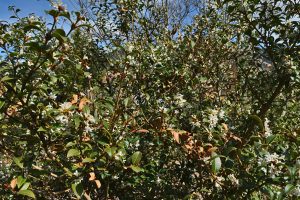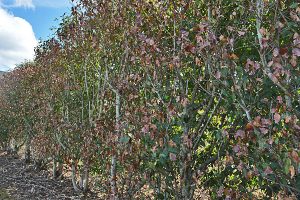
Fragrant osmanthus rarely sees winter damage…but it did this year!
With the wild weather of late December and early January behind us, and the return to more normal winter weather, we’re starting to see winter damage on many plants, especially broadleafed evergreens. Even ‘hardy’ evergreens and some conifers that experienced the sustained cold winds are showing some damage.
Where is the winter damage the worst? In areas that get the full brunt of the Fraser outflow winds – Sumas, Lynden, Everson, Ferndale in Whatcom County are definitely seeing damage. We’re also hearing of damage further south, where temperatures dipped to 10°F or lower. Plants that took the mild November weather as a “no need to go fully dormant” are also showing damage. And winter damage is showing up even on native conifers that have been drought stressed for the last few summers. All of these factors have lead to some brown leaves and needles.
What can a gardener do? The simplest answer is, wait. As new growth starts this spring, you should be able to see what is just wind burned, and what might be dead. Most broadleafed evergreens can be cut back to where new growth is pushing. For conifers, the burned needles will drop as new buds push. The plant make look a little sparse for a year or two, but should recover.
What about fruit trees? Were they hurt by the cold? For the most part, healthy, established fruit trees may see some bud damage. But this can be a win-win situation for us; if we have good pollination weather this spring, some damage will mean less fruit thinning this summer on these trees.
Some actions that can help prevent future winter burn in your garden –

The north side of this laurel hedge took a beating.
- Make sure your plants are not drought stressed in summer.
- Try to site broadleafed evergreens where there is some protection from NE winds.
- Accept that occasionally we will have this kind of cold spell, even though the winters are generally getting warmer.
Most healthy, established plants will survive this kind of winter- they may need some pruning, but will bounce back as spring progresses.

